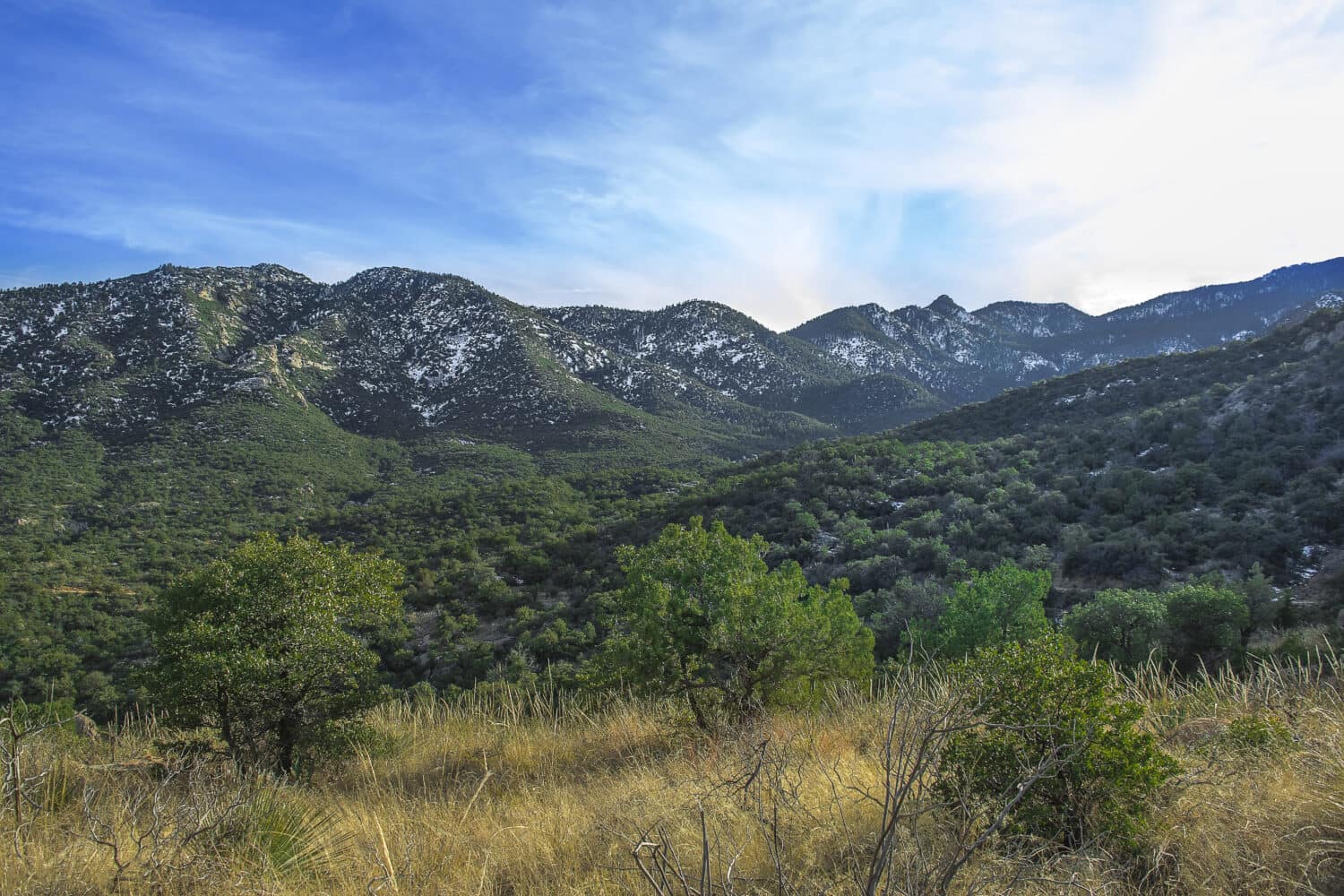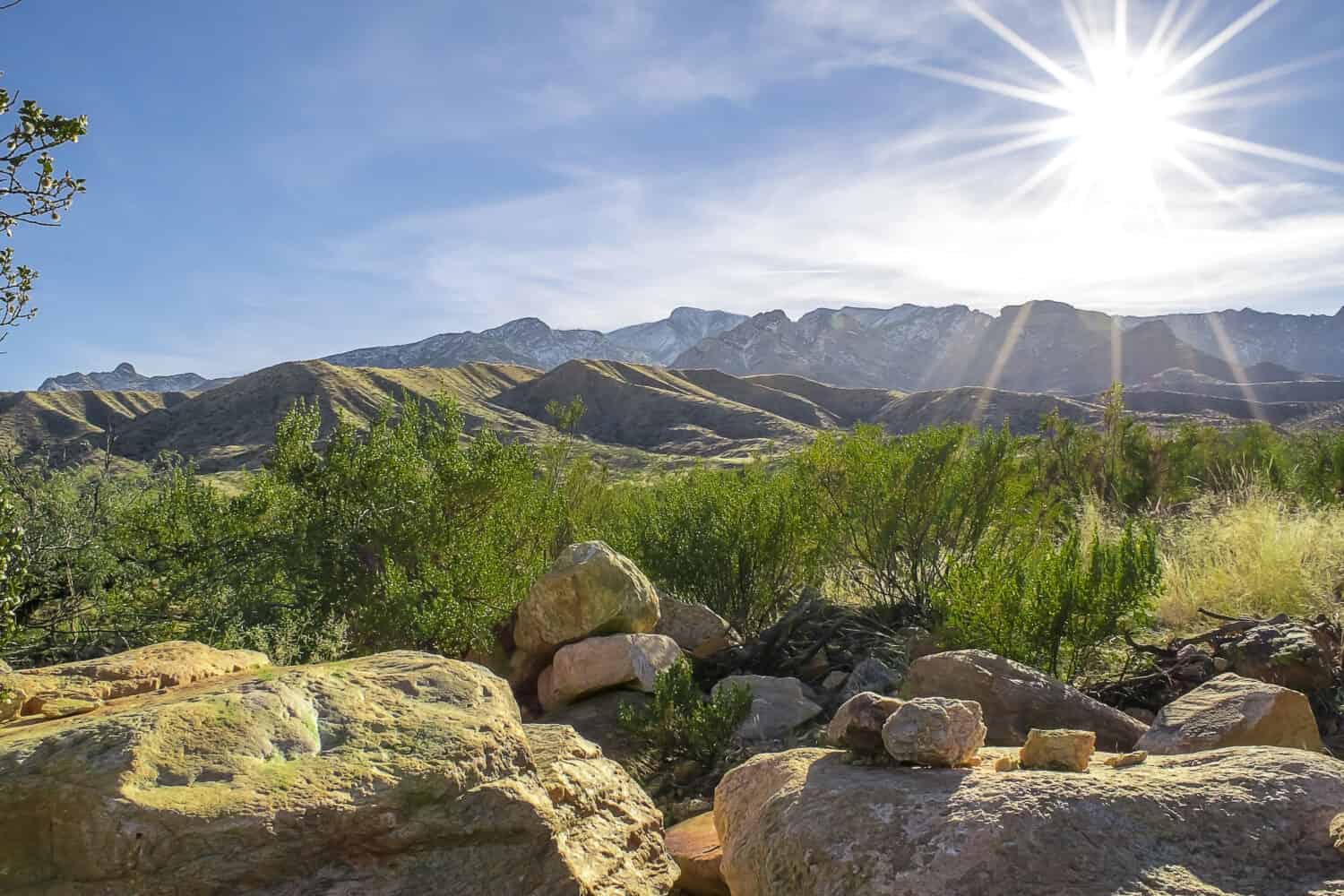In Arizona’s southeastern corner, Mount Graham is the highest peak in the Pinaleno Mountain range and the fourth highest in Arizona. The mountain holds a deep significance in the history and culture of the region. It is today a favorite destination for outdoor enthusiasts.
Mount Graham — also called High Peak — boasts an elevation of 10,724 feet (3,269 meters) above sea level.
Where Is Mount Graham Located on the Map?
As previously mentioned, Mount Graham is in Arizona’s southeast, close to New Mexico’s border. Mount Graham is approximately 151 miles (243 kilometers) northeast of Tucson and 199 miles (320 kilometers) east of Phoenix. The mountain is located in Graham County, from which it derives its name. It is the tallest peak of the Pinaleno Mountain range, a subrange of the larger Arizona-New Mexico Mountains.
Mount Graham is near the Sonoran Desert, characterized by arid landscapes and soaring temperatures. This contrasts sharply with the cooler and more temperate conditions found at higher elevations. Additionally, its location in Arizona makes it an ideal site for scientific exploration, specifically for astronomy. Its elevation and remote setting offer stunning night skies for celestial observation.
How Does Mount Graham Compare to Other Summits in the U.S.?
With an elevation of 10,724 feet (3,269 meters), Mount Graham seems small compared to some of the highest peaks in the United States. For example, Mount Denali, the highest peak in North America, is almost twice as tall as Mount Graham.
However, Mount Graham is still a notable peak, especially in the southwestern United States. It is the fourth-highest in Arizona and the 353rd countrywide.
| Summit Name | Location | Elevation (Feet) | Elevation (Meters) |
|---|---|---|---|
| Mount Denali | Alaska | 20,310 | 6,190.5 |
| Mount Whitney | California | 14,505 | 4,421 |
| Mount Elbert | Colorado | 14,440 | 4,401.2 |
| Mount Rainier | Washington | 14,417 | 4,394 |
| Grand Teton | Wyoming | 13,775 | 4,209.1 |
| Kings Peak | Utah | 13,534 | 4,125 |
| Mount Hood | Oregon | 11,249 | 3,428.8 |
| Mount Graham | Arizona | 10,724 | 3,268.6 |
| Haleakalā | Hawaii | 10,023 | 3,055 |
| El Capitan | Montana | 9,987 | 3,044 |
How Did Mount Graham Form?

Millions of years of geological evolution contributed to Mount Graham’s formation.
©Patrick Lansing/Shutterstock.com
Mount Graham formed through millions of years of geological processes. The formation of Mount Graham started with tectonic plate movements. The mountain’s location is part of the Basin and Range Province, a geologically active area in the southwestern United States. This area stretched and pulled apart the Earth’s crust, creating numerous mountain ranges and valleys.
In the area near Mount Graham, most of the peaks are lava deposits. However, according to research, Mount Graham blasted its way from under the Earth’s surface. It then rose to 10,724 feet above sea level.
Throughout millions of years, erosion, including weathering, water erosion, and glacial activity, finished to shape the landscape. Erosion carved out valleys and sculpted Mount Graham’s rugged terrain. Even today, geological processes (erosion, faulting, seismic activity) continue to shape the landscape, as they will for millions of years to come.
Unlike lava-based mountains, either barren or home to low shrubs, Mount Graham has a large population of trees. And most of them, according to research, date back to antiquity, around 1257 to 1270 AD. Those trees, most of them Douglas firs, survived thanks to the rocky cliffs, which prevented them from occasional wildfires. According to the same scientists, some dead Douglas firs around Mount Graham date from 1102 AD, early 12th century.
What Are the Wildfire Risks at Mount Graham?

Most fires at Mount Graham came from natural causes, mostly from lightning.
©Patrick Lansing/Shutterstock.com
Like many forested areas in the United States, Mount Graham and its surrounding forests are at risk of wildfires. Various factors can influence and increase wildfire risk.
The mountain’s forests, primarily composed of Douglas fir, pine, and mixed conifer species, can fuel large wildfires. If Douglas fir trees are evergreen and do not lose their leaves, other species will lose needles, leaves, and even branches. These can contribute to the start of an extensive fire.
The region experiences hot and dry summers in the summer, which can lead to increased fire danger. When humidity levels are low and combined with high temperatures, it can create conditions conducive to the rapid spread of wildfires. Additionally, thunderstorms break out in the summer after days of intense heat. These can sometimes bring lightning strikes, common natural ignition sources for wildfires, and will ignite dry vegetation into a fire.
If the vegetation has been under prolonged drought, it will be more susceptible to ignition, transforming into a fast-spreading fire and extremely hard to combat. Plus, firefighting efforts can be compromised in case of water shortage due to drought.
In addition to natural causes, human activities can start large and destructive fires. Campfires, discarded cigarette butts, or equipment sparks can be enough for a fire to start. When a fire happens, it usually increases the probability of another happening. When the past fire is still recent, the landscape has yet to have the time to recover and potentially still has some dry and dead vegetation to fuel a new fire.
Notable Fires in Mount Graham
Unfortunately, wildfires on and near Mount Graham happened in the past.
In 2004, the Nuttal and Gibson Complex Fire affected parts of Mount Graham. Caused by lightning, this fire mainly burnt ponderosa pine, mixed conifer, and spruce. It destroyed over 30,000 acres of vegetation but didn’t touch any structures or have any casualties. However, it came less than a mile close to the Mount Graham International Observatory (MGIO), which had to be temporarily evacuated.
More recently, in 2017, the “Frye Fire” burned over 48,000, including parts of Mount Graham. The fire was ignited after lightning struck vegetation on Mount Graham. This fire lasted almost three months, cost $26 million, and involved over 800 firefighters. It also destroyed three buildings and also threatened the Mount Graham International Observatory.
To fight against the fires, the U.S. Forest Service and local fire departments closely monitor fire risks in the area. Strategies to prevent wildfires also include controlled burns, fuel reduction projects, and fire restrictions. Visitors should always stay informed about current fire conditions, adhere to every fire restriction in place, and practice responsible fire safety very seriously when camping.
What Wildlife Live on Mount Graham?

In 2022, there were 152 Mount Graham red squirrels.
©Wirestock Creators/Shutterstock.com
Mount Graham’s transition between the desert terrain of its surroundings and its alpine meadows provides a dynamic environment that supports a diverse array of flora and fauna.
Squirrels
First is the Mount Graham red squirrel. This species, found exclusively on Mount Graham, boasts a stunning rust-colored fur and bushy tail. High conservation efforts are made to protect and preserve this unique squirrel population.
Along with this endemic population live the Abert’s squirrels. These tree-dwelling rodents with distinctive tufted ears prefer to live in the pine forests of the mountain.
Mammals
One of the largest mammals to live in Mount Graham is the black bear species. They are common in the forested areas and forage for food, including berries and acorns, in the mountain’s woodlands.
Cougars, or mountain lions, inhabit Mount Graham’s remote areas. They are the apex predator of the ecosystem in Mount Graham but are very elusive and rare to spot.
More easy to spot, and in a large population, mule deers live in the lower elevations of Mount Graham. They are known for their distinctive large ears and are a famous sight for wildlife enthusiasts.
Birds
In addition to squirrels and mammals, Mount Graham’s ecosystems provide the perfect habitat for various bird species.
Wild turkeys live in the Mount’s forests and are easily seen looking for food in the wooded area. Mexican spotted owls also live in the oldest parts of the forests on Mount Graham. Various conservation efforts are implemented to preserve this species and its nesting habitats.
Additionally, Mount Graham is home to other bird species, such as jays, raptors like hawks and eagles, warblers, and woodpeckers. The area is a haven for birdwatchers.
Reptiles, Amphibians and Insects
Finally, snakes, lizards, and various amphibian species live in the diverse habitats of Mount Graham. These species include garter snakes, tree frogs, and others. Various insects (bees, butterflies, etc.) also inhabit the area and play a vital role in the local ecosystems.
Thank you for reading! Have some feedback for us? Contact the AZ Animals editorial team.








